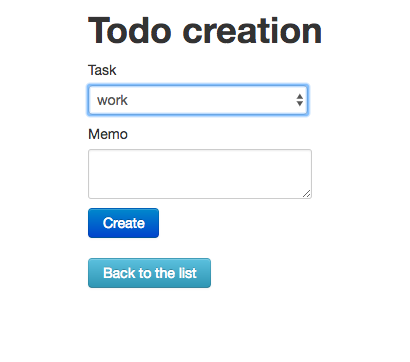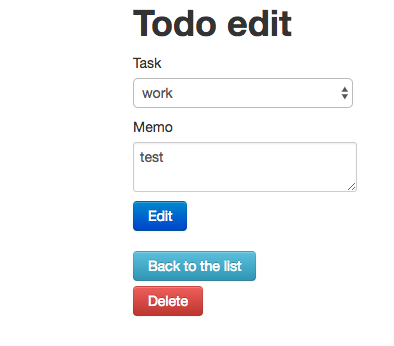はじめに
案件で何もわからないままsymfonyを使い始めたけど、日本語でのまとまった情報が少ない。。。
meetupとかあるみたいだけど、最近動きが少ない様に見える・・・(php界隈詳しくないので勘違いかもしれません)
特に情報がまとまっていることが少なかったForm関連のクラスを自動生成されたコードに少し手を加えたものを基本にまとめてみました。
今回使用したsymfonyのversionは2.8です。
実際に登録・編集 作ってみる
Entity
- まずはテーブルのEntityクラスを作成します。テーブルに連動したメンバーとgetter,setterを作成。
namespace AppBundle\Entity;
use Doctrine\ORM\Mapping as ORM;
/**
* ToDo
*
* @ORM\Table(name="to_do")
* @ORM\Entity(repositoryClass="AppBundle\Repository\ToDoRepository")
*/
class ToDo
{
/**
* @var int
*
* @ORM\Column(name="id", type="integer")
* @ORM\Id
* @ORM\GeneratedValue(strategy="AUTO")
*/
private $id;
/**
* @var string
*
* @ORM\Column(name="task", type="integer", length=1)
*/
private $task;
/**
* @var string
*
* @ORM\Column(name="memo", type="string", length=255, nullable=true)
*/
private $memo;
/**
* @var \DateTime
*
* @ORM\Column(name="r_datetime", type="datetime", nullable=true)
*/
private $rDatetime;
/**
* @var \DateTime
*
* @ORM\Column(name="u_datetime", type="datetime", nullable=true)
*/
private $uDatetime;
/**
* Get id
*
* @return integer
*/
public function getId()
{
return $this->id;
}
/**
* Set task
*
* @param string $task
* @return ToDo
*/
public function setTask($task)
{
$this->task = $task;
return $this;
}
/**
* Get task
*
* @return string
*/
public function getTask()
{
return $this->task;
}
/**
* Set memo
*
* @param string $memo
* @return ToDo
*/
public function setMemo($memo)
{
$this->memo = $memo;
return $this;
}
/**
* Get memo
*
* @return string
*/
public function getMemo()
{
return $this->memo;
}
/**
* Set rDatetime
*
* @param \DateTime $rDatetime
* @return ToDo
*/
public function setRDatetime($rDatetime)
{
$this->rDatetime = $rDatetime;
return $this;
}
/**
* Get rDatetime
*
* @return \DateTime
*/
public function getRDatetime()
{
return $this->rDatetime;
}
/**
* Set uDatetime
*
* @param \DateTime $uDatetime
* @return ToDo
*/
public function setUDatetime($uDatetime)
{
$this->uDatetime = $uDatetime;
return $this;
}
/**
* Get uDatetime
*
* @return \DateTime
*/
public function getUDatetime()
{
return $this->uDatetime;
}
/**
* @ORM\PrePersist
*/
public function refreshRDatetime()
{
$this->setRDatetime(new \Datetime());
}
/**
* @ORM\PrePersist
* @ORM\PreUpdate
*/
public function refreshUDatetime()
{
$this->setUDatetime(new \Datetime());
}
}
FormType
- 次にentityに結びついたFormTypeを作成します。
<?php
namespace AppBundle\Form;
use Symfony\Component\Form\AbstractType;
use Symfony\Component\Form\Extension\Core\Type as InputType;
use Symfony\Component\Form\FormBuilderInterface;
use Symfony\Component\OptionsResolver\OptionsResolver;
use Symfony\Component\Validator\Constraints;
class ToDoType extends AbstractType
{
/**
* {@inheritdoc}
*/
public function buildForm(FormBuilderInterface $builder, array $options)
{
$builder
->add('task',
InputType\ChoiceType::class,
[
'choices' => [
'1' => 'work',
'2' => 'hobby'
],
'constraints' =>
[
new Constraints\NotBlank()
]
]
)
->add('memo',
InputType\TextareaType::class,
[
'constraints' => [
new Constraints\NotBlank(),
new Constraints\Length(['max' => 255])
]
]);
$entity = $builder->getData();
if(!$entity->getId()){
$builder->add('Create', InputType\SubmitType::class,
[
'attr' => [
'class' => 'btn btn-primary'
]
]
);
}else{
$builder->add('Edit', InputType\SubmitType::class,
[
'attr' => [
'class' => 'btn btn-primary'
]
]
);
}
}
/**
* {@inheritdoc}
*/
public function configureOptions(OptionsResolver $resolver)
{
$resolver->setDefaults(array(
'data_class' => 'AppBundle\Entity\ToDo'
));
}
/**
* {@inheritdoc}
*/
public function getBlockPrefix()
{
return 'appbundle_todo';
}
}
- configureOptions
-
data_classの部分でこのFormTypeクラスと結びつくEntityのクラス名を指定しています。
-
- buildForm
- 基本的にどんなパターンの実装でも使う可能性があるのは、buildFormの中で記載されている
addメソッドです。この部分で実際にformに作成されるinputの種類とvalidationを記載することができます。 今回の場合はユーザーが編集できる項目はtaskとmemoの2つだけなので二つの項目をaddしています。 第1引数にメンバーの名前、第2引数にformの種類、第3引数にはoptionを渡せます。
- 基本的にどんなパターンの実装でも使う可能性があるのは、buildFormの中で記載されている
->add('task',
InputType\ChoiceType::class,
[
'choices' => [
'1' => 'work',
'2' =>'hobby'
]
],
[
'constraints' =>
[
new Constraints\NotBlank()
]
]
)
上記の部分ではToDoのEntityのtaskの入力項目を選択式(choiceType)でフォームを生成し、実際のセレクトボックスの選択肢を第三引数に配列でchoicesで渡しています。
Controller
- Controllerクラスです。自動生成で作成したのでCRUDが一通り実装されていますが、今回は新規と編集のみ説明します。
namespace AppBundle\Controller;
use AppBundle\Entity\ToDo;
use AppBundle\Form\ToDoType;
use Symfony\Bundle\FrameworkBundle\Controller\Controller;
use Sensio\Bundle\FrameworkExtraBundle\Configuration\Method;
use Sensio\Bundle\FrameworkExtraBundle\Configuration\Route;
use Symfony\Component\HttpFoundation\Request;
/**
* Todo controller.
*
* @Route("todo")
*/
class ToDoController extends Controller
{
/**
* Lists all toDo entities.
*
* @Route("/", name="todo_index")
* @Method("GET")
*/
public function indexAction()
{
$em = $this->getDoctrine()->getManager();
$toDos = $em->getRepository('AppBundle:ToDo')->findAll();
return $this->render('todo/index.html.twig', array(
'toDos' => $toDos,
));
}
/**
* Creates a new toDo entity.
*
* @Route("/new", name="todo_new")
* @Method({"GET", "POST"})
*/
public function newAction(Request $request)
{
$toDo = new Todo();
$form = $this->createForm(new ToDoType(), $toDo);
$form->handleRequest($request);
if ($form->isSubmitted() && $form->isValid()) {
$em = $this->getDoctrine()->getManager();
$em->persist($toDo);
$em->flush($toDo);
return $this->redirectToRoute('todo_show', array('id' => $toDo->getId()));
}
return $this->render('todo/new.html.twig', array(
'toDo' => $toDo,
'form' => $form->createView(),
));
}
/**
* Finds and displays a toDo entity.
*
* @Route("/{id}", name="todo_show")
* @Method("GET")
*/
public function showAction(ToDo $toDo)
{
$deleteForm = $this->createDeleteForm($toDo);
return $this->render('todo/show.html.twig', array(
'toDo' => $toDo,
'delete_form' => $deleteForm->createView(),
));
}
/**
* Displays a form to edit an existing toDo entity.
*
* @Route("/{id}/edit", name="todo_edit")
* @Method({"GET", "POST"})
*/
public function editAction(Request $request, ToDo $toDo)
{
$deleteForm = $this->createDeleteForm($toDo);
$editForm = $this->createForm(new ToDoType(), $toDo);
$editForm->handleRequest($request);
if ($editForm->isSubmitted() && $editForm->isValid()) {
$this->getDoctrine()->getManager()->flush();
return $this->redirectToRoute('todo_edit', array('id' => $toDo->getId()));
}
return $this->render('todo/edit.html.twig', array(
'toDo' => $toDo,
'edit_form' => $editForm->createView(),
'delete_form' => $deleteForm->createView(),
));
}
/**
* Deletes a toDo entity.
*
* @Route("/{id}", name="todo_delete")
* @Method("DELETE")
*/
public function deleteAction(Request $request, ToDo $toDo)
{
$form = $this->createDeleteForm($toDo);
$form->handleRequest($request);
if ($form->isSubmitted() && $form->isValid()) {
$em = $this->getDoctrine()->getManager();
$em->remove($toDo);
$em->flush();
}
return $this->redirectToRoute('todo_index');
}
/**
* Creates a form to delete a toDo entity.
*
* @param ToDo $toDo The toDo entity
*
* @return \Symfony\Component\Form\Form The form
*/
private function createDeleteForm(ToDo $toDo)
{
return $this->createFormBuilder()
->setAction($this->generateUrl('todo_delete', array('id' => $toDo->getId())))
->setMethod('DELETE')
->getForm()
;
}
}
- 新規作成
新規作成は下記のactionで行っています。$this->createForm(new ToDoType(), $toDo);の部分で空のentityとformTypeを渡し、formのインスタンスを作成し、view側に渡しています。$form->handleRequest($request)の部分でviewから渡されたRequestの中からEntityに紐づく値とformの状態を取得します。 値を取得した後if ($form->isSubmitted() && $form->isValid())の所で、$formがsubmitされているかつ、formTypeのvalidationが通るかを確認し、通った場合はdoctrineを使ってDBの登録を行います。
/**
* Creates a new toDo entity.
*
* @Route("/new", name="todo_new")
* @Method({"GET", "POST"})
*/
public function newAction(Request $request)
{
$toDo = new Todo();
$form = $this->createForm(new ToDoType(), $toDo);
$form->handleRequest($request);
if ($form->isSubmitted() && $form->isValid()) {
$em = $this->getDoctrine()->getManager();
$em->persist($toDo);
$em->flush($toDo);
return $this->redirectToRoute('todo_show', array('id' => $toDo->getId()));
}
return $this->render('todo/new.html.twig', array(
'toDo' => $toDo,
'form' => $form->createView(),
));
}
- 編集
次に編集部分の解説です。 編集と似た構成ですが、編集の場合は既存のentityを事前に取得するところが異なります。@Route("/{id}/edit", name="todo_edit")で指定した{id}の値を利用し、 既存のentityはParamConverterを介し、自動で取得しています。 取得したentityは第二引数に指定しています。 取得したtodoのentityをcreateFormの第二引数に渡すことでformに既存のentityの値を与えています。 残りの部分は新規作成と同様で$form->handleRequest($request)の部分でviewから渡されたRequestの中からEntityに紐づく値とformの状態を取得します。 値を取得した後if ($form->isSubmitted() && $form->isValid())の所で、$formがsubmitされているかつ、formTypeのvalidationが通るかを確認し、通った場合はdoctrineを使ってDBの登録を行います。
今回はdeleteの部分の説明は割愛します。
/**
* Displays a form to edit an existing toDo entity.
*
* @Route("/{id}/edit", name="todo_edit")
* @Method({"GET", "POST"})
*/
public function editAction(Request $request, ToDo $toDo)
{
$deleteForm = $this->createDeleteForm($toDo);
$editForm = $this->createForm(new ToDoType(), $toDo);
$editForm->handleRequest($request);
if ($editForm->isSubmitted() && $editForm->isValid()) {
$this->getDoctrine()->getManager()->flush();
return $this->redirectToRoute('todo_edit', array('id' => $toDo->getId()));
}
return $this->render('todo/edit.html.twig', array(
'toDo' => $toDo,
'edit_form' => $editForm->createView(),
'delete_form' => $deleteForm->createView(),
));
}
view
- 新規作成画面
新規作成画面はこれだけです。formを実際に作っている部分は下記のコードでform_startとform_endでformの開始、終了位置を指定、form_widget(form)の部分で渡されたTodoTypeにaddされた入力箇所のhtmlを出力しています。
{% extends 'base.html.twig' %}
{% block body %}
<h1>Todo creation</h1>
{{ form_start(form) }}
{{ form_widget(form) }}
{{ form_end(form) }}
<ul class="unstyled">
<li>
<a id="index" class="btn btn-info" href="{{ path('todo_index') }}">Back to the list</a>
</li>
</ul>
{% endblock %}
{{ form_start(form) }}
{{ form_widget(form) }}
{{ form_end(form) }}
- 編集 編集もほぼ同様です。
{% extends 'base.html.twig' %}
{% block body %}
<h1>Todo edit</h1>
{{ form_start(edit_form) }}
{{ form_widget(edit_form) }}
{{ form_end(edit_form) }}
<ul class="unstyled">
<li>
<a class="btn btn-info" href="{{ path('todo_index') }}">Back to the list</a>
</li>
<li>
{{ form_start(delete_form) }}
<input id="delete" class="btn btn-danger" type="submit" value="Delete">
{{ form_end(delete_form) }}
</li>
</ul>
{% endblock %}
最後に
symfonyではEntityにannnotionで直接validationを付与して、validationを行うことができます。
しかし、実際の実装において必ずしもentityの項目と
画面の項目の実装が一致するとは限りません。
実際のvalidation処理の管理はformTypeクラスに切り分けて、entityクラスは出来るだけ、実態に関連する項目や処理だけを入れた方がコードとして読みやすい気がします。
ちゃんと扱えれば、なんでも出来るframeworkだと思いますが、本当まとまった情報が少ない・・・
github
参考
http://api.symfony.com/2.8/Symfony/Component/Form/FormBuilderInterface.html#method_add
http://symfony.com/doc/current/reference/forms/types.html

